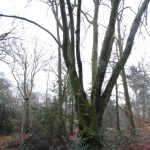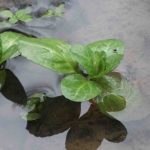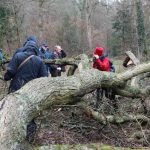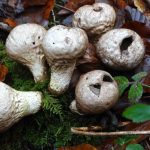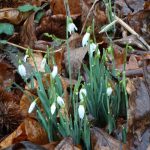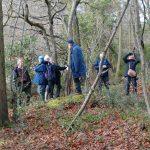Armed with a copy of Dick Greenaway’s ‘Veteran Trees for the Future’ map, John Lerpiniere led a walk round Ashampstead Common on the morning of Tuesday 23 January. Following severe gales the previous weekend, a number of trees had fallen across paths, making progress tricky. The first notable tree was a 200 year old Sweet Chestnut. This was followed by a big Holly, a 400 year old Beech and some big old Oak pollards. Nuthatch, Marsh Tit and numerous Great Tits were heard. After crossing the road, the next section had a number of tall conifers, including Douglas Fir, where the cones had distinctive antler-shaped bracts which were much longer than the scales, a Cedar with chunky round cones and a number of Scots Pines. Bright green Bluebell leaves were peeping up above the leaf litter. The path led to the edge of the woods, where many Snowdrops were coming into flower and flowers of Dog’s Mercury were also seen. Veteran trees in this part of the Common included Oak, Yew and Sweet Chestnut. In a puddle in a wet part of the path were Brooklime and a Starwort. Two Roe Deer ran through the woods and two different Muntjac Deer were spotted. Crossing back over the road, a thicket of young Ash trees showed signs of Ash Dieback disease. A very steep-sided chalk pit was circumnavigated in an unsuccessful hunt for a notable Sycamore. The next path led to a wide ride which is kept open by volunteers. The Hazel bushes at the sides were covered in catkins and the first of the red female flowers were seen. Towards the lower boundary of the wood was a big bank with a ditch on the inside, showing that this had once been a deer park and the bank was there to keep the deer in. A big Beech pollard was 5.5 metres in girth and at least 350 years old. The map showed Wild Service-tree beyond the bank but just inside the wood. Careful searching revealed many Wild Service-tree leaves on the ground, but it took a bit of detective work to work out which were the trees themselves. Pale-backed leaves revealed the presence of Whitebeam in the chalky part of the wood, but not much further along the path acid-loving Gorse was in flower. A Buzzard flew low above people’s heads and along the path ahead. The route led back to the car park and the group then continued to the Red Lion at Upper Basildon for lunch.
Pictures by Laurie Haseler

